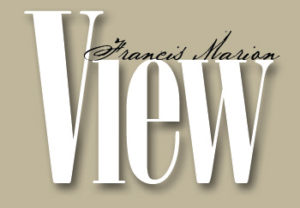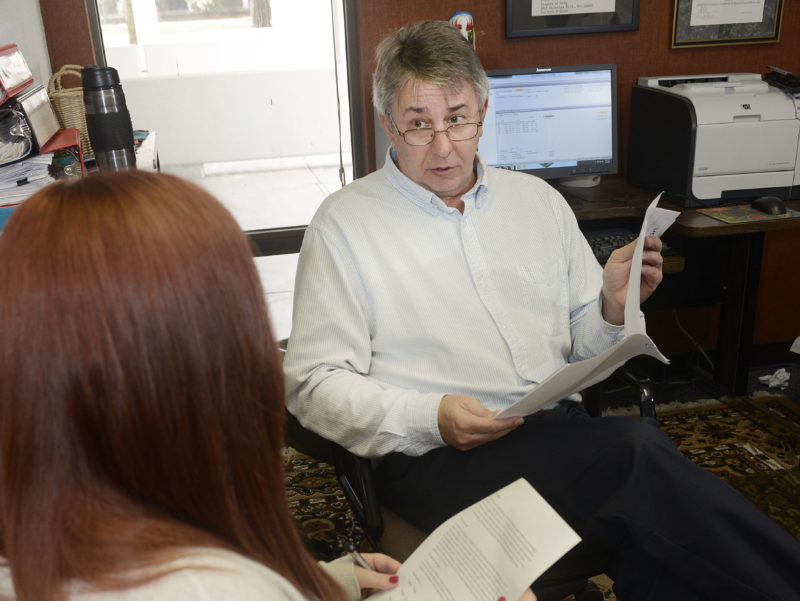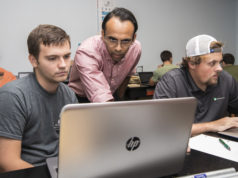Francis Marion University’s cadre of artist-professors straddle two worlds in a never-ending balancing act
When Lucas Berry first saw the famous “Wall of Pain” outside Dr. Jon Tuttle’s office at Francis Marion, he didn’t know quite what to think. Here was a respected, and successful American playwright, and on the wall were dozens – no, hundreds – of rejection letters sent by assorted publishers and the like giving Tuttle, in writing, a resounding “no!”
“But once he explains it, it makes sense,” says Berry, a senior from Greenville. “He wants you to know that everyone gets rejected, so, if you’re going to do this and are going to feel bad about that, well, get over it. It’s not about you. Plays can be rejected for all kinds of reasons, but if you know your work is good, then it’s good. Doesn’t matter what these other guys say.
“It’s an important lessons,” says Berry, “but I don’t think it would be quite the same coming from someone who didn’t actually do this for a living. They could say it but it would be as … as real.”
Berry is hardly the only FMU student to enjoy, and benefit from, a dose of realism in the classroom. A dozen or more FMU professors, across a range of disciplines, are bonafide artists, real masters in many cases, who teach on the side.
Or, maybe it’s the other way around. They are master teachers who work in a chosen artistic field on the side.
Or … well, maybe it’s just not quite clear which comes first, the artistic chicken or the academic egg. Working two equally intense careers can be a real jumble, say those who try it. But most, most of those at FMU anyway, say it is a richly rewarding experience, one that benefits them and their students.
“It’s a win-win I think,” says Professor Julie Mixon, who teaches photography and also works professionally a photographer and photographic artist. “Students benefit from what I do and what I learn. And because I work at a university that’s so supportive of research, I’ve been able to write some grants, to do some things with students that have been very, very good.”
Says Tuttle, “Every day I’m surrounded by students with the same fever for literature and writing, and it’s infectious,” says Tuttle. “My job is to go in and inspire them but much of the time that current runs both ways. … Even when I’m not practicing playwriting, I’m discussing it.”
The VIEW recently spoke with five of FMU’s master artists cum faculty for a look inside their dual career balancing act, and some insight on the benefits of actually practicing what you preach.
The rock star
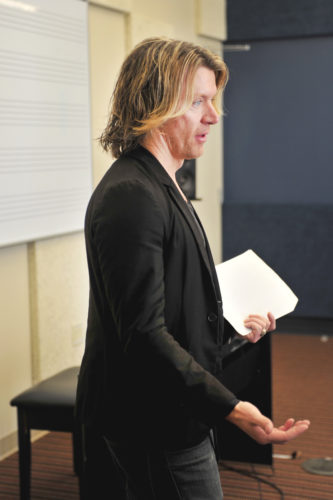
Back in the old days, Brandon Goff not only looked and sounded like a rock star, he was a rock star.
For the better part of two straight years he toured the world with Christian rocker Doug Pierce.
Now? He’s just a music professor at Francis Marion University.
Oh, for the good ol’ days, right?
“I don’t know,” says Goff. “Everybody thinks that’s the life until you try it. But all that travel, trying to get along with the same five or six people on the road for 10 straight months … That will wear you out, burn you out. That was easily the most exhausting period of my life. Today … here with my students, doing a few other things. Now this is the life.”
If that sounds Goff has his feet propped up, waiting for someone to bring him a drink out by the pool, think again. He’s not on tour, wrangling rockers and ducking groupies anymore (at least not full time). But he is still crazy busy, still a self-processed “frantic mess.”
Asked just before Thanksgiving to delineate what he is doing right now – besides teaching music and composition theory at FMU – Goff produces a list that sounds just about as exhausting as his old “if it’s Tuesday-this-must-be-Dusseldorf” routine. The chore list includes:
- Writing music for Christian TV show called “Armor.” Goff spends at least 30 minutes on that task every morning – after a bike ride.
- Working with his now, long-time friend Doug Pierce to plan this summer’s tour for their band Willy Pete. The band has been touring European military bases for the past six summers, supporting U.S. soldiers overseas. FMU students often accompany the band, sometimes performing and sometimes serving as “roadies.”
- Making final preparations for a small “tour” in Europe over the Christmas Break. Goff will play on radio shows in England and to Germany, more or less promoting the Willy Pete summer tour, and will play with a “huge jazz band” for a couple of nights.
- Working on a commissioned piece for the Florence Symphony Orchestra.
“Like I said, I’m still kind of a mess,” says Goff. “But that’s the way I like it. That’s the way it should be in this business.”
Goff never really considered giving up one of his careers for the other. In large part that’s because the academics and the music industry work have always been so intertwined. That began in college at Arkansas State University when a professor asked a then-teenage Goff if he had time to look at some new software the school had just purchased, learn to use it, and then teach the professor (and other faculty members) how to use it.
The software was an early digital music editing and production program.
“It’s hard to imagine now, when everything is computerized, but that was way, way back when they were just rolling all that stuff out,” says Goff. “The faculty knew they needed it, that this was coming, but no one there had any clue what to do with it. So they said to me, ‘if you’ll figure out how to do this we’ll give you a stipend.’ They knew I was good guitar player who produced some music and who had even made my own cassettes, so they figured I could do it.”
Goff could. In fact, he learned the software so well that he soon was in demand at recording studios in Memphis (about 45 miles from campus) and later Nashville. One thing led to another. The computer production work led to some studio musician work and other production work and, says Goff, “just a variety of gigs.
“That’s how you do it,” he says. “You do a bunch of small things, make a bunch of contacts, and pretty soon it is a big thing that you have done, and that stuff you were doing for a stipend you’re doing for real money.”
Goff continued to bounce back and forth. He composed, played, performed and produced while earned his Masters from ASU and later, his doctorate from Memphis University. A recommendation from a professor at Memphis landed him an adjunct job at prestigious Rhodes College (also in Memphis) and that eventually led to a full-time posting there. A few years later he jumped at the chance to help launch the new Music Industry program in the new performing arts center at FMU.
Goff says his ongoing industry work continues to inform his teaching. It allows him to stay up to date. It also gives him a platform from which to dispense career advice. For the most part, he says, “do what I do.”
“I encourage my students to take an extreme path like I did,” says Goff. “Go on tour, stay up all night writing music or watching how-to videos on youtube. Work your tail off, learn to do as many things as you can. That’s how you do it in this business. I was never the best guitar player or the best producer, but I could do a little bit of everything and, I got along with people fairly well. That’s how you can make it. All my students can do that – if they will.”
There is one part of the path that Goff does not recommend, however.
Teaching music at a university.
Which is too bad because, says Goff, that might be the best part of what he does.
“This,” says Goff, “is a very good gig and I’ve been very fortunate. But, there just aren’t many full-time teaching jobs in the arts., I tell my students, one career I wouldn’t plan on is being me. Sorry guys, doesn’t happen very often.”
A real balancing act
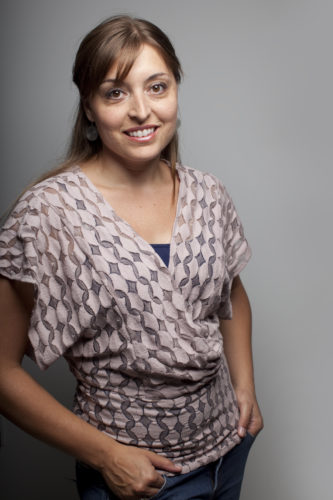
As it turns out, the balancing act between being a professional photographer and teaching photography professional at Francis Marion University is really no big deal.
Julie Mixon learned that last year when she gave birth to her first child.
The arrival of little Eliza in late 2015, and all the disruption that brought to Mixon’s life, made her old dual career juggling seem like … no, not like child’s play. Mixon knows what that’s like. But, well easier.
“Let’s just say a baby is another whole level of balance,” says Mixon. “There’s really nothing like it.”
And in truth, Mixon never found balancing her career as an artist and a professor all that challenging. One sprang accidentally, and naturally, from the other. They have co-existed ever since, perhaps even enjoying a symbiotic thriving.
Thinking about the mix of academic and professional work, Mixon says, “The thing about teaching is that it’s basically learning. I’ve learned far more as a teacher, far more I think, than I would have learned on my own if I was just out working. So it’s been a good combination.
“If you’re going to teach something, if you have to explain it, you really, really have to know it,” says Mixon. “Teaching has made me so much better at what I do.”
Mixon professional work includes the stock-and-trade of professional photography – weddings, corporate portraiture, etc. – but also some artistic work, which is her first love. Her work is a regular feature of local galleries, and a photo she shot while on a trip with some FMU students recently honorable mention in a show at the Darkroom Gallery in Essex, UT.
Balancing all that has been as hard, maybe harder, than balancing professional photography with teaching.
“Within the profession one of the hard things is figuring out what to do,” says Mixon. “I can make so much more shooting weddings, but is that what you really want to do? I try to include some art in the weddings I shoot, both because it’s different and valuable to the customer, but also because I like it. I guess that’s one of the things I like about teaching. It lets me do more of what I like.”
Mixon stumbled into photography while in high school, rescuing a 35-milimeter camera from a shelf in her parent’s home where it was gathering dust. But she didn’t really think of it as a career when she went off to college at the University of North Carolina Wilmington. Like about half the freshmen there, she imagined herself a marine biologist.
“But, I found out pretty quickly that I enjoyed exercising the other side of my brain, too,” says Mixon. “So I changed majors, changed colleges (on to Barton) and went into photography.”
She finished her degree and headed to grad school with no real goal in mind other than to continue her budding love affair with the camera and images it can produce. But midway to her masters, a professor asked her if she liked to try a gig teaching a darkroom class at a nearby community college.
Mixon tried it, liked it, and the balancing act was on.
“I did not think I’d like teaching,” Mixon says, “but teaching something you love is different from … just teaching.”
Mixon says the mix of activities and genres is instructive and useful to her students. Photography covers a broad area these days and Mixon rarely has students with exactly the same career interests. The more she knows, the more she does, the most students she can relate.
It’s always a balancing act. Especially now.
Light bulbs and fake hair
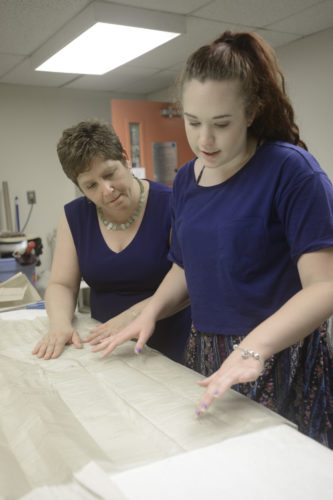
There was never much doubt that Allison Steadman was going to do something in the world of fashion and clothing. Growing up she made intricate paper dresses for her Barbie dolls and her mother recalls that little Allison always wore “outfits,” not just clothes. By the time she was in middle school, Steadman had designed her own line of clothing.
But a precise career line did not appear until the light bulb went off one day in a high school drama class.
“It just sort of dawned on me one day that for the plays to look the way it looked, there must be somebody who puts the clothes on all those people,” says Steadman. “So I asked my teacher, ‘who is that person? Who does that?’ And I found about costume designers and here I am.”
A few years, and a twist or turn later, Steadman is bonafide professional costume designer, with mile-long list of show credits from around the country to her credit. She’s also a Professor of Fine Arts at Francis Marion University, where she specializes in teaching costume design, makeup and other specialities in the Theatre Arts Program – and delights in the “light bulb” moments she helps her students experience.
“I remember I had a student a few years ago who was doing some sewing in the costume shop one day and all of suddenly he kind of realized that he really understood what he was doing, that this was something that was easy for him, and here was a path he might follow,” says Steadman. “It was electric.
“Those are the moments you live for,” says Steadman, “to see the excitement in a student’s eyes when they realize they have an idea that’s really innovative, or when they ‘get’ something that’s just been out of reach. I’ve had my light bulbs. It’s exciting to see theirs.”
Steadman discovered the feeling while working as an employee at the University of Tennessee’s costume shop, following her graduation from the UT graduate program in costume design. Although it wasn’t a teaching job – UT’s theatre program was so large that it employed full-time designers to assist with university productions – Steadman was teaching all the time, helping students learn the craft outside of the standard classroom.
That inspired Steadman to consider teaching, in addition to her burgeoning career as a designer for summer playhouses and regional theatres around the country.
Like all master artists who teach, Steadman says balancing one career with the other challenging. But it’s also beneficial.
“The design work I do helps me translate the theory into something that’s ‘real world,’” says Steadman. “It gives me street cred. But it’s clear to me that what I do in the classroom helps me when I’m designing, and vice versa. One informs the other. It’s a nice combination.”
Steadman, who has design credits from more than 100 different shows, had a few pangs of regret early in her teaching career. She wondered if she was “settling,” perhaps giving up too quickly on a dream.
But the dream, she has discovered, never really died. She spends most of every summer designing costumes and helping a production team create characters somewhere on the East Coast; and the opportunity to teach what she loves has allowed her to build one of the more unique Curriculum Vitaes around. Steadman’s credentials includes papers and presentations with titles like, “Getting the Most Out of Fake Hair,” “Flesh-tearing Special Effects,” and “Affordable Corsets.”
“It is an interesting business,” says Steadman.
You never know when the next light bulb will go off.
He dreamed of … teaching
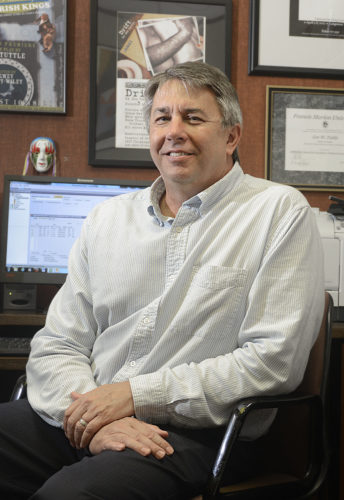
Jon Tuttle is no slouch when it comes to writing plays. Two of his works have been produced at the prestigious Theater of Note in Los Angeles, and for nearly two decades he’s been the playwright in residence at the Trustus Theater in Columbia, S.C.
“And,” says Tuttle, “I’ve actually got an agent on Broadway. A good agent. That’s my elevator pitch. I’ve had a little rain (monetary success) fall on me. Not much, but a little.”
In other words, he’s done okay, maybe more than okay. And that, of course, leads to a question that dogs all artists-cum-professors: what if they bagged that teaching stuff and concentrated, really concentrated, on their art?
The ever-thoughtful Tuttle ponders the question for just a second. No need for deeper thought now. He’s been here before.
“There was a point, I do remember it, remember having this feeling of being frustrated because my teaching job kept me from writing,” Tuttle says. “But then about as soon as that came to mind I thought, ‘you idiot! That was your dream. You always imagined being a good enough playwright to get a job like this (teaching at Francis Marion). And you’ve done that. How can you be frustrated?”
Tuttle has had enough success as a playwright, has enough friends in the “serious playwright” world, to understand the profession’s brutal pragmatic side. Talent and technical brilliance matter, but only a little. Less than five percent of those who self-identify as a “professional playwright” come anywhere to close to actually making a living through their work. And that five percent reports an average salary that’s essentially in line with the average salary for all Americans.
One of Tuttle’s playwright friends, Donald Marguiles, won a Pulitzer (Prize) for his play Dinner with Friends,” and has had his work adapted for film and TV. But, says Tuttle, “even he will tell you that there is not really a lot of money to be made.
“Even at his level it is feast or famine,” Tuttle says. “I think he’s doing pretty well, but it’s not a good way to get rich.”
Needless to say, Tuttle can deliver a dose of realism to his students. He’s been in litigation that pertained to his works, had to deal with wacky agents and cantankerous fellow authors, and then, of course, there’s “Wall of Pain.” The wall came down recently during some Founders Hall renovation work. Tuttle says he hopes to restore in one day, perhaps opening it up to the documented rejections and disappointments of others as well. He wants to do that, thinks it is important. But there’s more to his classroom spiel than “been there, done that.”
“The whole business can be very frustrating and I can bring that students,” says Tuttle. “But I don’t want to talk to them about that. I’d rather enjoy working with these amazing kids on the front end of this, at a time when they’re excited about the creative process and having something to say and all. That’s really something much better, much more fun because about once a year or so one of them will just do something fantatstic, just knock it out of the park and well, you really can’t replace that.”
The accidental novelist
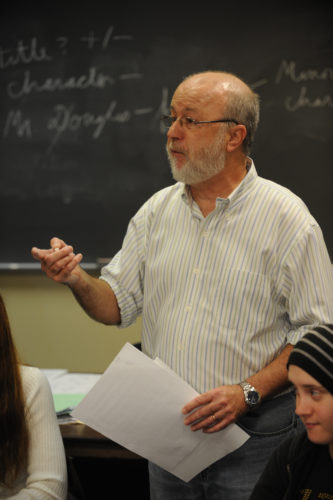
Lynn Kostoff has published four novels (with a fifth on the way) and has taught thousands of students, but he never intended to be a novelist …
… or a professor.
“In fact,” says Kostoff, a professor in the FMU English Department and the university’s writer-in-residence. “I think it’s fair to say that just about everything I’ve done has been by accident.”
Kostoff was raised in the countryside outside Youngstown, Ohio, hardly a hotbed of intellectualism. But he did have a grandfather who loved to read and who engaged Kostoff in that passion. That probably accounts for the novelist bent – almost 40 years later Kostoff still reads better than a book a week and regularly tells students the only way they’ll ever learn to write is to read – but is was no easy road. Kostoff got into Bowling Green State University because he ranked high in a small high school class. He came armed with a good sense of self-awareness and, as he quickly found out, not much else.
“I realized early on that I was basically a dumbass,” says Kostoff.
Impressed by the erudition of two English professors he met early in this career, he asked both for a reading list of books he should know. Both provided said list and then were stunned to discover Kostoff actually running through it. What’s more, he kept coming by their office, wanting to discuss what he’d read. Impressed, both profs took Kostoff seriously, a turning point, he says, in his life.
That set him on course for a degree in English, and eventually a Masters of Fine Arts in Creative Writing, which was fine. Kostoff loved all the reading and showed some talent for the writing. But he realized, as most students in that discipline eventually do, that he still had to eat. Kostoff’s solution: take a low-end-of-the-totem pole teaching job, serving as instructor in remedial English (technically it was called Developmental Composition) to a roomful of semi-literate BGSU jocks.
“They needed to learn this, had to pass this course, to stay eligible and get through school, and I really needed the money,” Kostoff. “We were all a bunch of rejects at the bottom of the pole. We hit it off great. They were so needy. I really had to teach my tail off, but I did and some of them appreciated it and actually got better. And I realized then, ‘hey, I can teach!’ I thought there might be something there.”
There was. Kostoff graduated and landed a similar position at Indiana State (where the basketball team included a not especially gifted student named Larry Bird); and then a few years later at the University of Alabama, where he received weekly phone calls from coach Paul “Bear” Bryant, checking to make sure “his boys” were doing okay.
Kostoff continued to work on his writing, and one his ideas for novels, while all this was going on. He never really thought of it as two careers. It was just what he did: teach and write.
And, it’s what he still does today.
Kostoff calls the existence “schizophrenic,” largely because the pace of the two pursuits is so discordant. The rush from beginning to end of a scholastic semester stands in sharp contrast to the plodding pace of a professional novelist.
“It’s almost tortoise and hare kind of stuff,” says Kostoff. “In the classroom you’ve got to keep your students on track, on what always seems to me to be a very fast schedule. Then, there’s the writing where I may be working on something that’s four or five years in the making, and where a useable page a day is a good goal.”
Because it was for years his only real source income – he didn’t publish his first novel until 1991, almost 15 years into his academic career – Kostoff has always viewed teaching as his “job.”
“My students always come first,” he says. “There’s no question about that. But, because I’ve always understood the discipline required of a writer, it’s never been a problem. Oh, it’s easy to get frustrated at times, but that’s just part of it.”
Kostoff can share an assortment of writer’s war stories with his students, and certainly understands that, as a writer, he can “offer the author’s point of view, can inhabit a writer’s work and maybe show the students how they can do that, too.”
That may be helpful to the aspiring author or critic, but deeper insights can mold young minds. Lynn Kostoff, the self-described dumbass from the Ohio back country, preaches diligence and a sort of cleansing humility to his students. It is the lesson of his two-headed career.
“A lot of the writing I’ve done, it’s been like an apprenticeship,” says Kostoff. “Lots of people don’t think that’s good. They want the keys right away. That’s always an issue with my students. But anything worthwhile take time, and nothing but time. Like Falubert said, ‘talent is a long patience.’ And it is.
“You’re going to be humbled by your job and that’s fine. It’s fine to an apprentice, to be learning something. I’m fine with all that. I see everything I write, maybe even writing, as a draft.”
Students chaff at this notion, but Kostoff does not relent. Every year, in every class, he makes the same assignment: keep a personal log for a day. In it, students must write down everything they do that day.
“Then, a few days later,” says Kostoff, “we come to class and divide the log into the things that matter and the things that are b.s. It’s a humbling sort of exercise because mostly you find that you’re spending a lot of time on b.s.
“But that’s okay,” Kostoff says. “It’s good to learn that, too.”
